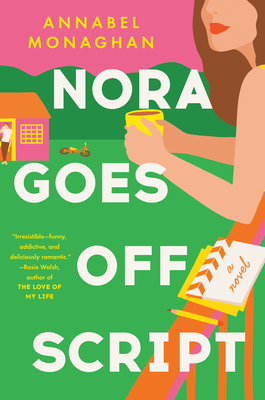 Nora Goes Off Script by Annabel Monaghan
Nora Goes Off Script by Annabel Monaghan Format: eARC
Source: supplied by publisher via Edelweiss
Formats available: hardcover, large print, paperback, ebook, audiobook
Genres: contemporary romance, relationship fiction, women's fiction
Pages: 272
Published by G.P. Putnam's Sons on June 7, 2022
Purchasing Info: Author's Website, Publisher's Website, Amazon, Barnes & Noble, Kobo, Bookshop.org, Better World Books
Goodreads
Nora's life is about to get a rewrite...
Nora Hamilton knows the formula for love better than anyone. As a romance channel screenwriter, it's her job. But when her too-good-to work husband leaves her and their two kids, Nora turns her marriage's collapse into cash and writes the best script of her life. No one is more surprised than her when it's picked up for the big screen and set to film on location at her 100-year-old-home. When former Sexiest Man Alive, Leo Vance, is cast as her ne'er do well husband Nora's life will never be the same.
The morning after shooting wraps and the crew leaves, Nora finds Leo on her porch with a half-empty bottle of tequila and a proposition. He'll pay a thousand dollars a day to stay for a week. The extra seven grand would give Nora breathing room, but it's the need in his eyes that makes her say yes. Seven days: it's the blink of an eye or an eternity depending on how you look at it. Enough time to fall in love. Enough time to break your heart.
Filled with warmth, wit, and wisdom, Nora Goes Off Script is the best kind of love story--the real kind where love is complicated by work, kids, and the emotional baggage that comes with life. For Nora and Leo, this kind of love is bigger than the big screen.
My Review:
This initially anti-romantic Nora actually writes those made-for-TV-sponsored-greeting-card-company romances that the Nora in yesterday’s book initially believed cast her as an unfeeling villain in every single outing. Unlike the romances that either of them reads, writes, agents or even watches, the particular script that this Nora is dealing with when this story begins is the story of her own life, and it’s about to be filmed in her very own picturesque but slightly run down home.
Or rather, it’s about to be filmed on her lawn and in “The Tea House” on the grounds where she does her writing. It’s a bit of art imitates life imitates art, as that Tea House was her emotional escape from an emotionally abusive but otherwise absent husband. It was the place where she wrote the scripts that literally kept their life afloat – because the asshole was just too “good” – at least by his own definition – to go out and get a damn job to contribute to the household.
Which also wasn’t good enough for him in any way, shape or form. Not Nora, and not their two kids. So he upped and left and she was actually pretty damn happy about it. She chose not to be a victim of any of her circumstances, and that’s her story and it sold and it’s being filmed and just the fees from using her house for part of the movie shoot is going to get her out of the debt the asshat left her in.
But her asshat ex is being played by the Sexiest Man Alive, and Nora is just a bit smitten. Or at least her fantasy life has suddenly taken on some new dimensions. Still, Leo Vance’s invasion of her life and occasionally her house is just a bit of excitement in her otherwise pretty ordinary and pretty contented life.
And she can’t wait for the film crew to be gone so she can get back to writing. But when the film crew leaves, Leo decides to stay. And stay. And STAY.
That’s where what was merely a blip – although a pretty damn big blip – of excitement turns into a whole lot more. Leo doesn’t just camp out in her tea house, he becomes part of her life and the lives of her two kids, Arthur and Bernadette. In a few short weeks, they become a family.
It’s easy for all of them to fall for him. He’s more involved in all their lives than the asshat EVER was. And it’s not an act. He’s not playing a part. So when Nora and Leo finally give in to the simmering tension between them, it seems like something that shouldn’t be possible might be possible after all. They might, just maybe and possibly, have some kind of future. No matter how much that seems like a fairytale.
But just when they do – they don’t. Leo gets a call, jets off to LA and then to Asia to film a big movie, and he ghosts the whole family. He misses all the things he promised he’d come back for and just disappears out of their lives if not out of their hearts.
Howsomever, this isn’t Nora’s first time on this particular merry-go-round. She wasn’t a victim before, and she isn’t going to be one now. She knows what to do. She writes her pain. She picks up the pieces and moves on. She survives.
It’s then, and only then, that the truths finally come out. The only question is whether or not it’s too late.
 Escape Rating A: I fell into this one nearly as hard as I did Book Lovers, and that’s saying a lot. The two romances have a lot in common, particularly in the way that they both mix in a lot of relationship elements. Because this isn’t just a romance between the scriptwriter and the actor, it’s also a love story about the actor and the scriptwriter’s kids. They have to be able to become, not just a couple but actually a family in order for this to even possibly work.
Escape Rating A: I fell into this one nearly as hard as I did Book Lovers, and that’s saying a lot. The two romances have a lot in common, particularly in the way that they both mix in a lot of relationship elements. Because this isn’t just a romance between the scriptwriter and the actor, it’s also a love story about the actor and the scriptwriter’s kids. They have to be able to become, not just a couple but actually a family in order for this to even possibly work.
And Nora is as surprised as anyone – if not a bit more so – that it might possibly work. So she’s not surprised at all when it doesn’t. Heartbroken this time around, but not surprised.
One of the things that makes celebrity romances so much fun – especially when they work as well as this one does, is that we’ve probably all had that daydream at least once or twice – if not a whole lot more times. It’s not remotely likely or even plausible, but it’s fun to dream.
But to make it work as in a novel that dream has to at least seem like it might possibly come true in this one particular case. (Spoiler Alert and All the Feels, both by Olivia Dade, also play with this idea but in a completely different way.) And it does seem to be working in Nora Goes Off Script – at least from Nora’s perspective.
Howsomever, because the story is told entirely from Nora’s point of view, we get why it works but we also see exactly how much she questions whether the relationship has ANY long term potential whatsoever. She knows she wants it to, but she’s realistic about wondering whether it can. That we don’t see things from Leo’s point of view means that we share her doubts and totally get why, when he disappears it’s disappointing but not as surprising as either she – or we – want it to be.
(Some of the folks in my reading circle saw these events as a giant misunderstandammit. While it’s true that the mess might have been cleared up by a conversation or a series of texts in their particular case, because of the agency in the middle of things it was easy to see that that conversation actually couldn’t happen. YMMV, as theirs obviously did.)
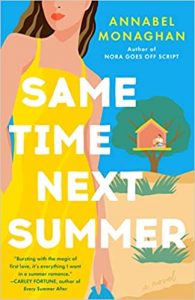 That all of Nora’s justified angst does lead to both another big money script sold to Hollywood AND to an HEA without her having to compromise a thing – because she shouldn’t – was a surprise and a delight. The ending fed the fantasy in a way that made this reader end the book with a big smile on my face – although probably not as big a smile as the one on Nora’s daughter Bernadette’s face.
That all of Nora’s justified angst does lead to both another big money script sold to Hollywood AND to an HEA without her having to compromise a thing – because she shouldn’t – was a surprise and a delight. The ending fed the fantasy in a way that made this reader end the book with a big smile on my face – although probably not as big a smile as the one on Nora’s daughter Bernadette’s face.
Nora Goes Off Script is the author’s debut adult novel, although she has previously published both YA fiction and grown-up nonfiction. I’m so very happy that there is more where this one came from, and I’m looking forward to reading her sophomore adult romance, Same Time Next Summer, coming out THIS summer!

 Book Lovers by
Book Lovers by  Two years later, unbeknownst to each other, in the middle of trips that they’ve each been separately strong-armed into, they run into each other in the tiny town of Sunshine Falls, NC, to discover that their enmity isn’t really all that strong, but their bantering snarkitude is excellent.
Two years later, unbeknownst to each other, in the middle of trips that they’ve each been separately strong-armed into, they run into each other in the tiny town of Sunshine Falls, NC, to discover that their enmity isn’t really all that strong, but their bantering snarkitude is excellent. City Under One Roof by
City Under One Roof by  On my other hand, I’m not totally sure the slow burn romance between Cara and one of the local cops was completely necessary. The story was plenty compelling without wondering will they/won’t they.
On my other hand, I’m not totally sure the slow burn romance between Cara and one of the local cops was completely necessary. The story was plenty compelling without wondering will they/won’t they.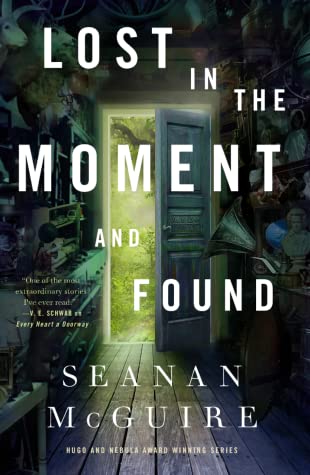 Lost in the Moment and Found (Wayward Children, #8) by
Lost in the Moment and Found (Wayward Children, #8) by 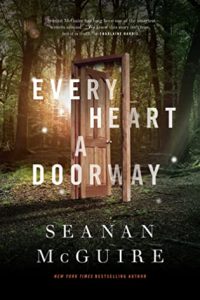 Escape Rating A-: Considering that the author spoils this in an Author’s Note at the very front of the book, I don’t feel at all bad about doing it here as well. Because honestly, if she hadn’t told me up front that Antsy was going to rescue herself from the grooming, gaslighting monster in her own house I wouldn’t have made it through the first chapter.
Escape Rating A-: Considering that the author spoils this in an Author’s Note at the very front of the book, I don’t feel at all bad about doing it here as well. Because honestly, if she hadn’t told me up front that Antsy was going to rescue herself from the grooming, gaslighting monster in her own house I wouldn’t have made it through the first chapter.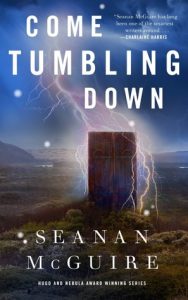 Which won’t stop me from reading the next book in the
Which won’t stop me from reading the next book in the 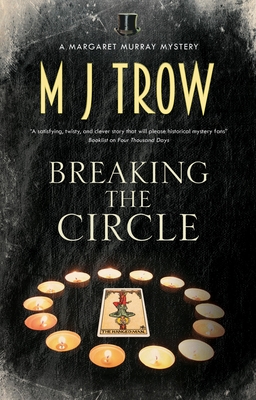 Breaking the Circle (Margaret Murray, #2) by
Breaking the Circle (Margaret Murray, #2) by 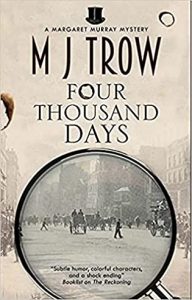 Escape Rating A-: What makes this series work, at least for this reader, is the voice of its protagonist Dr. Margaret Murray. Not just because she was a real person – as were both Flinders Petrie and Edmund Reid, but because she led the kind of life, had the type of career, and left behind the writing to make the adventures that her fictional avatar gets herself into seem not just plausible but even possible.
Escape Rating A-: What makes this series work, at least for this reader, is the voice of its protagonist Dr. Margaret Murray. Not just because she was a real person – as were both Flinders Petrie and Edmund Reid, but because she led the kind of life, had the type of career, and left behind the writing to make the adventures that her fictional avatar gets herself into seem not just plausible but even possible.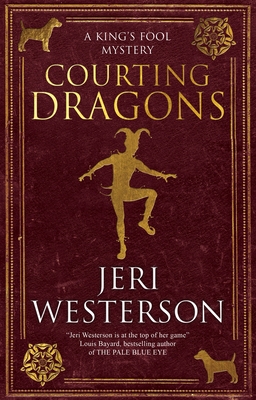 Courting Dragons (A King's Fool mystery, 1) by
Courting Dragons (A King's Fool mystery, 1) by 
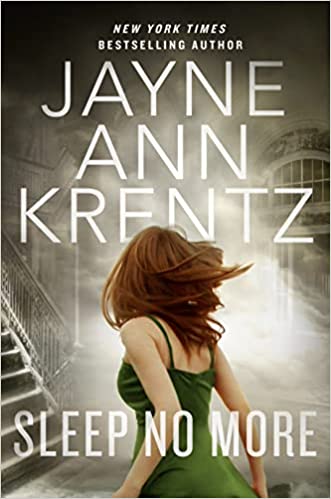 Sleep No More by
Sleep No More by  Escape Rating A-: The fascinating thing about this very fun read is that it is very much a three-pronged story, and all those prongs come together to hold a rather lovely gem of a book.
Escape Rating A-: The fascinating thing about this very fun read is that it is very much a three-pronged story, and all those prongs come together to hold a rather lovely gem of a book. But the third prong was the hook for me. As many vibes and auras surround Pallas and Ambrose, it really seems like the motives for everything that happens to them in the story itself are rather mundane criminal activities even if they are conducted at higher stakes than usual. It seems like the events that brought them to Carnelian California all revolve around people behaving badly because of money and then covering it up. Following the money is a tried and true investigative principle for damn good reasons, after all.
But the third prong was the hook for me. As many vibes and auras surround Pallas and Ambrose, it really seems like the motives for everything that happens to them in the story itself are rather mundane criminal activities even if they are conducted at higher stakes than usual. It seems like the events that brought them to Carnelian California all revolve around people behaving badly because of money and then covering it up. Following the money is a tried and true investigative principle for damn good reasons, after all.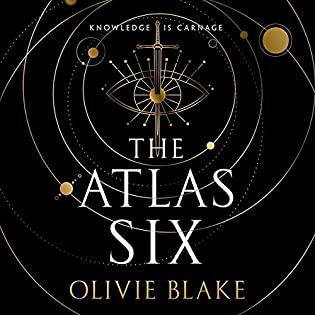 The Atlas Six (The Atlas, #1) by
The Atlas Six (The Atlas, #1) by  Which admittedly does ramp up the tension VERY dramatically for the second book in the series,
Which admittedly does ramp up the tension VERY dramatically for the second book in the series, 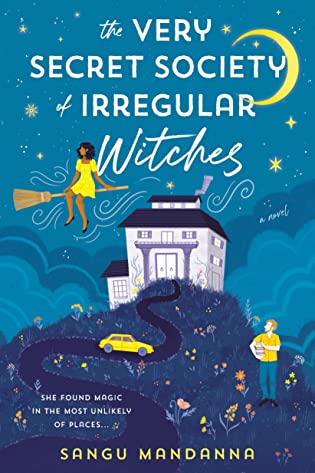 The Very Secret Society of Irregular Witches by
The Very Secret Society of Irregular Witches by  Escape Rating A-: The Very Secret Society of Irregular Witches was absolutely charming – and I was utterly charmed by it. It’s a heartwarming read with just the right touch of magic to keep you turning pages, both to be part of this wonderful if extremely irregular household and to see what happens next.
Escape Rating A-: The Very Secret Society of Irregular Witches was absolutely charming – and I was utterly charmed by it. It’s a heartwarming read with just the right touch of magic to keep you turning pages, both to be part of this wonderful if extremely irregular household and to see what happens next.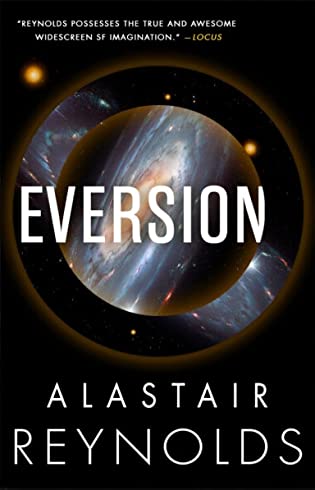 Eversion by
Eversion by  Escape Rating A: The author of Eversion is best known for his epic, space opera type science fiction, but if that’s what you’re looking for you’re not going to find it in Eversion. Very much on the other hand, if you enjoyed the small-scale, small-cast, intimate story of his
Escape Rating A: The author of Eversion is best known for his epic, space opera type science fiction, but if that’s what you’re looking for you’re not going to find it in Eversion. Very much on the other hand, if you enjoyed the small-scale, small-cast, intimate story of his